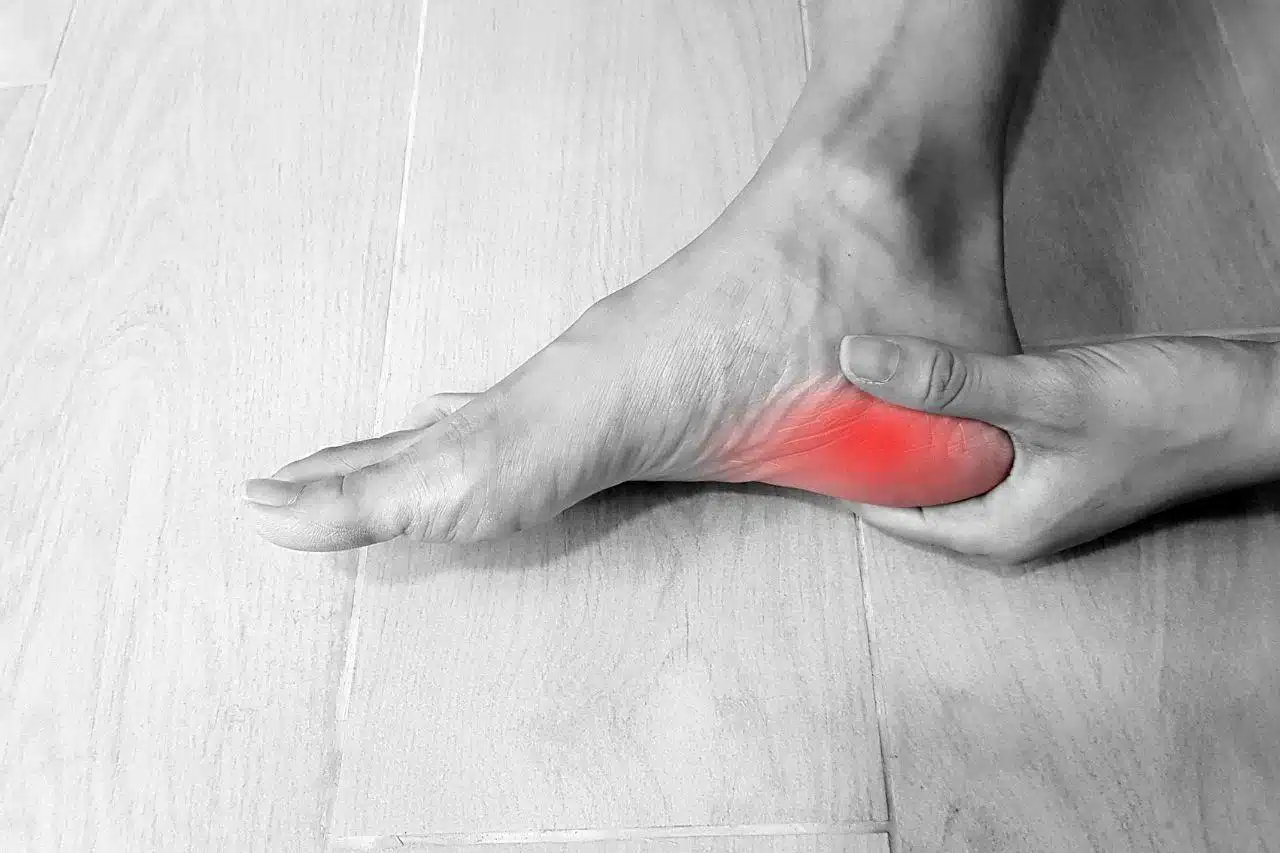Plantar Fasciitis is the most common form of heel pain. Heel pain affects approximately 85% of people at some time in their life. It affects men and women equally, and it can occur at any age. Heel pain is often caused by a combination of factors such as obesity, lack of exercise, wearing high-heeled shoes, genetics and overuse. Plantar fasciitis is a condition that causes inflammation of a thick band of tissue (the plantar fascia) that runs along the bottom of the foot. The plantar fascia connects the heel bone to the toes and provides support to the foot’s arch. When this tissue becomes inflamed, it stiffens and causes the arch of the foot to flatten out. This results in excessive pressure being placed on the heel bone, which then starts to hurt. The exact cause of plantar fasciitis is not known.
WHAT CAUSES PLANTAR FASCIITIS PAIN?
No two cases of plantar fasciitis are exactly the same, but there are several factors that seem to make a person more likely to develop the condition:
Obesity: People who are obese have an increased risk of developing plantar fasciitis. In fact, one study found that people with a body mass index (BMI) of 30 or higher had 3.2 times the odds of developing the condition compared to people with a normal BMI.
Genetics: Having flat feet may increase your risk of developing plantar fasciitis.
Weak foot muscles: Plantar fasciitis is more common in people with weak foot muscles. Weak foot muscles can occur from injury or simply from not exercising the feet enough.
Some of the more common causes include:
Over-pronation (abnormal rolling in of the foot during walking)
Wearing high-heeled shoes
Poor foot biomechanics
Excess weight
Genetics
Inadequate rest and sleep
Repetitive strain injuries (RSI)
Diabetes
RISK FACTORS & SYMPTOMS OF PLANTAR FASCIITIS
Compared to other types of heel pain, such as tendonitis and stress fractures, the symptoms of plantar fasciitis are often more subtle and difficult to identify. The first sign that you might have the condition is usually pain in the heel that worsens at the end of the day and after periods of inactivity. Heel pain may also be accompanied by a burning sensation, a sharp pain that shoots down the outside of the heel, or a tingling feeling that spreads up the bottom of the foot. In more severe cases, you may experience difficulty walking and even limping. The most common symptom of plantar fasciitis is pain that occurs while walking.
Moreover, you may notice that the foot pain gets worse when you walk on a hard surface like concrete or asphalt. It may also get worse when you are wearing shoes with high heels.
Consequently, the plantar fascia connects the calf and heel bone to the toes and provides support to the arch of the foot. When this tissue becomes inflamed, it stiffens and causes the arch of the foot to flatten out. This results in excessive pressure being placed on the calf stretch heel bone. You may find it hard to walk for any length of time without experiencing discomfort.
HOW TO DIAGNOSE PLANTAR FASCIITIS
Physiotherapists and chiropractors can help with proper treatment of this diagnosis. Physiotherapists can give their impression while a chiropractor can give their diagnosis. Moreover, both professions can offer specific treatments that will ease the discomfort and allow you to resume your active lifestyle.

The first step in diagnosing plantar fasciitis is to rule out other conditions that can cause similar symptoms. Your chiropractor will conduct a physical examination of your foot and ask you questions about your symptoms and past medical history. Your chiropractor will look for signs of injury, deformity, inflammation, and infection during the examination.
To reliably diagnose plantar fasciitis, your health care professional will need to perform a more comprehensive exam. He will need to examine your gait (the way you walk), the way your foot moves within your shoe, and the way your foot moves when you are standing still.
PLANTAR FASCIITIS PAIN RELIEF
Preventing plantar fasciitis is easier than curing it. The first step in exercises for plantar fasciitis is to wear comfortable, low-heeled shoes. You should only wear high-heeled shoes if they fit correctly and if you have adequate support in the heel. It is also important to exercise and strengthen your foot muscles. This will help to keep your foot strong and prevent it from becoming weak.
Plantar fasciitis can be very difficult to treat. This is because the condition is caused by a combination of factors, and it is often not clear which factor is the main culprit.
A heel that is abnormally shaped due to a problem with the growth of the bone in the heel can also contribute to plantar fasciitis. In such cases, your doctor may recommend surgery to reshape the bone in the heel.
However, there are several things you can do to decrease your chances of getting the condition:
Wear properly fitted, low-heeled shoes: Heels that are too high can irritate and inflame the soft tissue, that supports your arch.
Get plenty of rest: Lack of rest and sleep increases your body’s natural inflammation.
Elevate your foot: Place your leg on a small stool or books under your feet when you are sitting to reduce the pressure on your heels.
Take an anti-inflammatory: This will help to reduce the swelling and pain.
Strengthen your calf muscles: Weak muscles can lead to excess strain on your foot.
Exercise: Exercise increases your circulation and helps to strengthen your muscles.
Be careful about the type of exercise you perform: If you exercise on hard surfaces like concrete or asphalt, your risk of injury increases. Try exercising on a soft surface like a treadmill or a carpeted floor.
If you follow these simple guidelines, you should be able to prevent chronic plantar fasciitis either from occurring or, if it does occur, it should be much easier to treat.
The good news is that plantar fasciitis is often a temporary condition, and you do not have to live with it for the rest of your life. In fact, many people who have the condition are able to completely stop it from recurring. This is because they learn to manage the condition properly.
SHOCKWAVE THERAPY
Here at Northwest Rehab Group, we often suggest our patients try shockwave therapy. It has very low intensity, and there are almost no side effects.
Shockwave therapy is a non-surgical option that uses high-energy shockwaves to help repair and rebuild tissue and cartilage in the body. It has been proven to be very effective in the treatment of heel pain caused by plantar fasciitis and other conditions.
As a result, therapy treatment for plantar fasciitis is a non-invasive procedure that uses high-energy sound waves to break up scar tissue and promote healing. Scar tissue is the result of an injury to your body and can form in any part of your body, including your heel.
Plantar fasciitis is caused by this type of injury to your heel. A gel medium is placed on the affected area during the procedure, and a focused beam of high-energy sound waves is directed at the area. These sound waves cause tiny micro-explosions within the injured tissue. This causes the scar tissue to rupture, break down, and eventually be replaced with healthy, new tissue.
There are several different types of shockwave therapy machines. Typically, it is a small, hand-held machine that you can use anywhere you have a chair or a bed.
You simply lie down on your treatment table and hold on to the arms while the technician positions the device over your heel. The device uses a continuous waveform, and it has a variable rate of energy delivery. This allows your heel to be treated at the lowest possible energy level needed to ensure complete healing. Many people experience immediate relief from intense pain after just one treatment.
CUSTOM ORTHOTICS AND PLANTAR FASCIITIS

Many people with plantar fasciitis have a hard time finding relief. This is because they are not using the right product or the right combination of products. There are many over-the-counter (OTC) and prescription products available that do not work.
Orthotics can help a multitude of conditions from the foot all the way up the body. If one part of the body is not functioning properly, it can change the mechanics of the rest. We can alleviate this problem and get your plantar fascia back to working correctly with our custom orthotics.
This is a product that is becoming more and more popular. Our custom plantar fascia orthotics are made with a unique material that gently contours to the bottom of your foot. This provides support and comfort for not only your toes but plantar fascia.
To illustrate, let’s say you are standing on a chair. Without the proper orthotics, when the weight of your body comes down on the heels of your feet, the pressure is transmitted up through your legs and into your knees. This can cause discomfort and sometimes even injury. With our orthotics, the pressure is evenly distributed between your orthotics and your natural foot because of the unique material they are made with.
It’s like you have your own personal cushion that disperses the pressure away from your plantar fascia. This allows your body to function at its optimal level, which in turn allows your plantar fascia to heal.
Final words
In conclusion, plantar fasciitis is a common and often painful condition that affects the heel. It can be caused by a combination of factors such as obesity, genetics, weak foot muscles, overuse, and poor foot biomechanics. The symptoms of plantar fasciitis include heel pain, burning sensations, sharp pains, and difficulty walking. A comprehensive examination by a healthcare professional is necessary to diagnose the condition.
While plantar fasciitis can be challenging to treat due to its multifactorial nature, several strategies can help relieve the pain and promote healing. These include wearing properly fitted, low-heeled shoes, getting sufficient rest and sleep, elevating the foot to reduce pressure, taking anti-inflammatory medication, strengthening calf muscles, and engaging in suitable exercise on soft surfaces.
Shockwave therapy is a non-surgical treatment option that has shown effectiveness in addressing plantar fasciitis. It utilizes high-energy shockwaves to break up scar tissue and promote healing in the affected area. Custom orthotics are another approach that can provide support and comfort to the foot, relieving pressure on the plantar fascia and aiding in its healing.
It is important to note that plantar fasciitis is often a temporary condition, and with proper management and treatment, many individuals can prevent its recurrence and resume an active lifestyle. Seeking the guidance of physiotherapists or chiropractors can provide valuable assistance in the treatment and rehabilitation process.
Overall, a comprehensive approach that includes appropriate footwear, lifestyle modifications, targeted therapies like shockwave therapy, and custom orthotics can significantly contribute to relieving plantar fasciitis pain and facilitate the healing process. By implementing these strategies and seeking professional guidance, individuals can regain their mobility and minimize the impact of plantar fasciitis on their daily lives.
Don’t let plantar fasciitis hinder your daily activities any longer. Take the first step towards recovery by booking an appointment at Northwest Rehab Group. Let us help you regain your mobility and overcome plantar fasciitis for good.
Book your appointment today and experience the difference at Northwest Rehab Group. Your journey to pain-free feet starts here.






0 Comments